

Enquête sur les origines du langage : mais quelle est l'histoire de ces mots basiques qui se prononcent de la même manière dans presque toutes les langues ? Un groupe de chercheurs a démontré que beaucoup de mots qui veulent dire la même chose dans différentes langues ont le même son.L'exemple le plus frappant est le son "i", qui est très souvent utilisé dans différentes langues pour désigner quelque chose de "petit”.Cette nouvelle étude renforce l'idée qu'une partie de l'origine de la création des langues est onomatopéique et mimétique.

Atlantico : Pouvez-vous décrire un peu plus en détails sur les tenants et les aboutissants de cette nouvelle étude publiée dans Proceedings of the National Academy of Sciences (voir ici)? Philippe Blanchet : En préambule, il me semble important de préciser que la démarche de ces chercheurs, qui ont comparé le sens et les sons des mots propres à 240 langues différentes, s'inscrit dans une longue lignée de travaux allant dans le même sens. Par exemple, ils avancent que le mot "rouge" commence très fréquemment par un "r", quelque soit la langue parlée. atlantico sur facebook notre compte twitter. Les débuts de l'humanité. Niche construction. Beavers hold a very specific biological niche in the ecosystem: constructing dams across river systems.
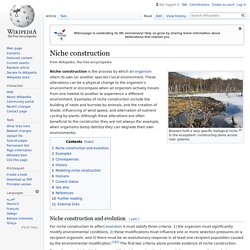
Niche construction is the process by which an organism alters its own (or another species') local environment. These alterations can be a physical change to the organism’s environment or encompass when an organism actively moves from one habitat to another to experience a different environment. Examples of niche construction include the building of nests and burrows by animals, and the creation of shade, influencing of wind speed, and alternation of nutrient cycling by plants. Although these alterations are often beneficial to the constructor they are not always (for example, when organisms dump detritus they can degrade their own environments).
Origin of language. The first language in the human species has been the topic of scholarly discussions for several centuries.

There is no consensus on the origin or age of human language. The topic is difficult to study because of the lack of direct evidence. Consequently, scholars wishing to study the origins of language must draw inferences from other kinds of evidence such as the fossil record, archaeological evidence, contemporary language diversity, studies of language acquisition, and comparisons between human language and systems of communication existing among animals (particularly other primates). Many argue that the origins of language probably relate closely to the origins of modern human behavior, but there is little agreement about the implications and directionality of this connection.
This shortage of empirical evidence has led many scholars to regard the entire topic as unsuitable for serious study. Language acquisition. Pidgin. Simplified language A pidgin[1][2][3] , or pidgin language, is a grammatically simplified means of communication that develops between two or more groups that do not have a language in common: typically, its vocabulary and grammar are limited and often drawn from several languages.
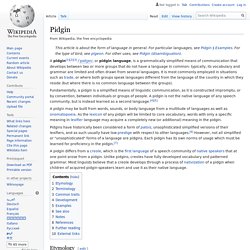
It is most commonly employed in situations such as trade, or where both groups speak languages different from the language of the country in which they reside (but where there is no common language between the groups). Fundamentally, a pidgin is a simplified means of linguistic communication, as it is constructed impromptu, or by convention, between individuals or groups of people. Stratum (linguistics) Thus, both terms refer to a situation where an intrusive language establishes itself in the territory of another, typically as the result of migration.

Whether the superstratum case (the local language persists and the intrusive language disappears) or the substratum one (the local language disappears and the intrusive language persists) applies will normally only be evident after several generations, during which the intrusive language exists within a diaspora culture. In order for the intrusive language to persist (substratum case), the immigrant population will either need to take the position of a political elite or immigrate in significant numbers relative to the local population (i. e., the intrusion qualifies as an invasion or colonisation; an example would be the Roman Empire giving rise to Romance languages outside Italy, displacing Gaulish and many other Indo-European languages).
A superstratum (plural: superstrata) or superstrate offers the counterpart to a substratum. Creole language. Stable natural languages that have developed from a pidgin A Guadeloupe Creole sign stating Lévé pié aw / Ni ti moun ka joué la!
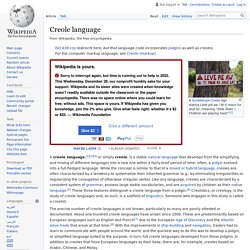
, meaning "Slow down / Children are playing here! " Language bioprogram theory. The language bioprogram theory or language bioprogram hypothesis[1] (LBH) is a theory arguing that the structural similarities between different creole languages cannot be solely attributed to their superstrate and substrate languages.
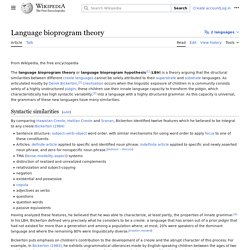
As articulated mostly by Derek Bickerton,[2] creolization occurs when the linguistic exposure of children in a community consists solely of a highly unstructured pidgin; these children use their innate language capacity to transform the pidgin, which characteristically has high syntactic variability,[3] into a language with a highly structured grammar. As this capacity is universal, the grammars of these new languages have many similarities. Syntactic similarities[edit] By comparing Hawaiian Creole, Haitian Creole and Sranan, Bickerton identified twelve features which he believed to be integral to any creole:[citation needed] Verbal system[edit] The verb conjugation is typically close to an ideal tense–modality–aspect pattern. Creole Prototype[edit] Adam's Tongue, Derek Bickerton - The Book Show - ABC Radio National. Roots of language. Synopsis Roots of language was originally published in 1981 by Karoma Press (Ann Arbor).
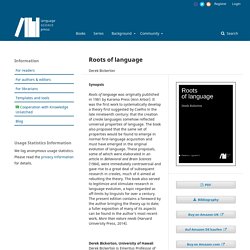
It was the first work to systematically develop a theory first suggested by Coelho in the late nineteenth century: that the creation of creole languages somehow reflected universal properties of language. The book also proposed that the same set of properties would be found to emerge in normal first-language acquisition and must have emerged in the original evolution of language. These proposals, some of which were elaborated in an article in Behavioral and Brain Sciences (1984), were immediately controversial and gave rise to a great deal of subsequent research in creoles, much of it aimed at rebutting the theory.
The book also served to legitimize and stimulate research in language evolution, a topic regarded as off-limits by linguists for over a century. Derek Bickerton, University of Hawaii Derek Bickerton is Emeritus Professor of Linguistics at the University of Hawaii. Statistics. Derek Bickerton. Derek Bickerton (born March 25, 1926) is a linguist and Professor Emeritus at the University of Hawaii, Manoa.
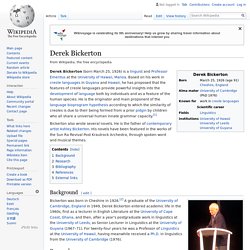
Based on his work in creole languages in Guyana and Hawaii, he has proposed that the features of creole languages provide powerful insights into the development of language both by individuals and as a feature of the human species. He is the originator and main proponent of the language bioprogram hypothesis according to which the similarity of creoles is due to their being formed from a prior pidgin by children who all share a universal human innate grammar capacity.[1] Bickerton also wrote several novels. He is the father of contemporary artist Ashley Bickerton. His novels have been featured in the works of the Sun Ra Revival Post Krautrock Archestra, through spoken word and musical themes. John Maynard Smith. Un article de Wikipédia, l'encyclopédie libre.

John Maynard Smith John Maynard Smith, né le à Londres et mort le à Lewes dans le Sussex de l'Est, est un biologiste de l'évolution et un généticien britannique. Biographie[modifier | modifier le code] Pendant la Seconde Guerre mondiale, Maynard Smith est ingénieur en aéronautique. Protéine Forkhead-P2. Carte du gène FOXP2 humain. Linguistique comparée. La linguistique comparée (ou encore linguistique comparative, linguistique historique ou grammaire comparée) est une discipline de la linguistique qui étudie l'histoire et l'évolution des langues (prises individuellement) ou des familles de langues. C'est une discipline éminemment diachronique, notamment lorsqu'il s'agit de classifier les langues, mais l'aspect synchronique est également à considérer lorsqu'il s'agit de comparer deux langues ou plus, à une époque précise, d'un point de vue purement grammatical.
La linguistique comparée procède de la philologie, terme qui, parfois, doit être compris comme un synonyme bien que les deux disciplines soient différentes. Langage humain. Pour un article plus général, voir Langage. Le langage humain est un système qui regroupe le développement, l'acquisition, l'entretien et l'utilisation de systèmes complexes de communication, et désigne aussi la capacité humaine permettant ces processus. Une langue est un exemple spécifique d'un tel système de communication (par exemple, la langue française). L'étude scientifique du langage en tant que système de communication relève du domaine de la linguistique. Société de linguistique de Paris. Origine du langage.